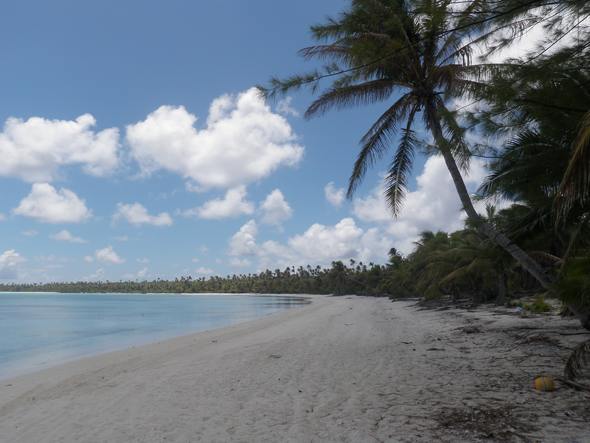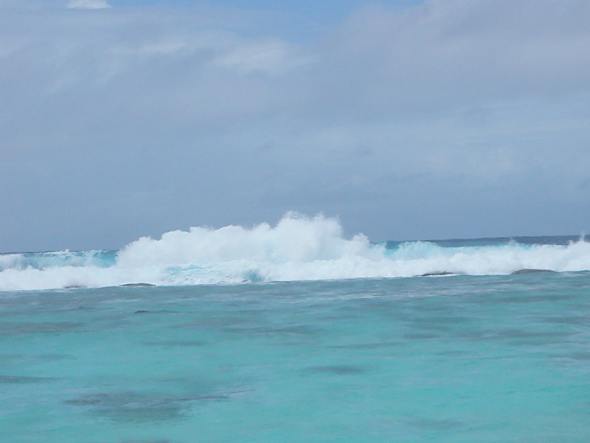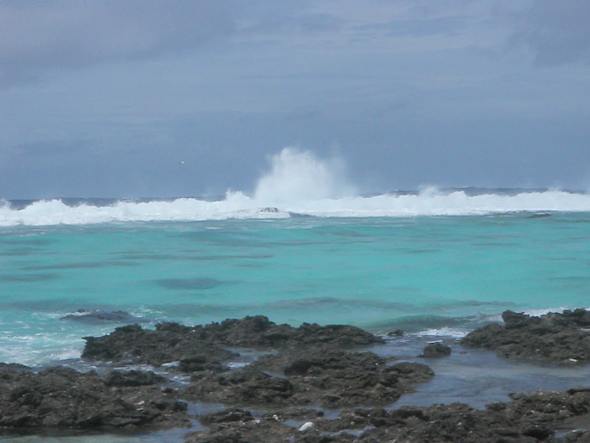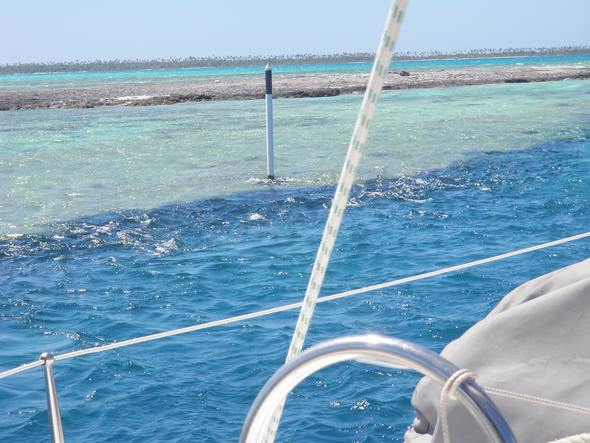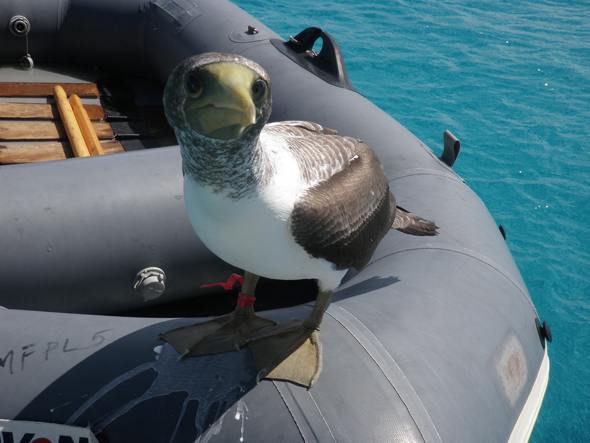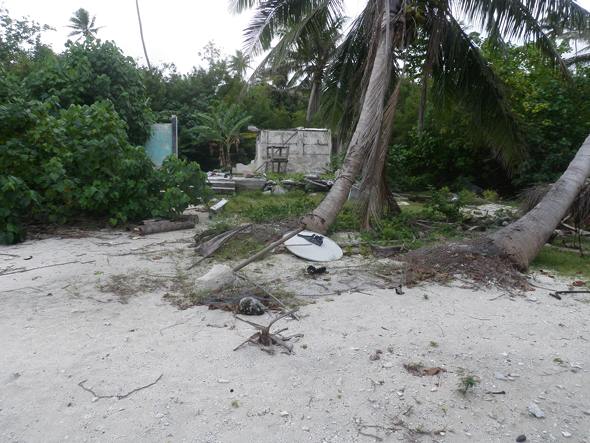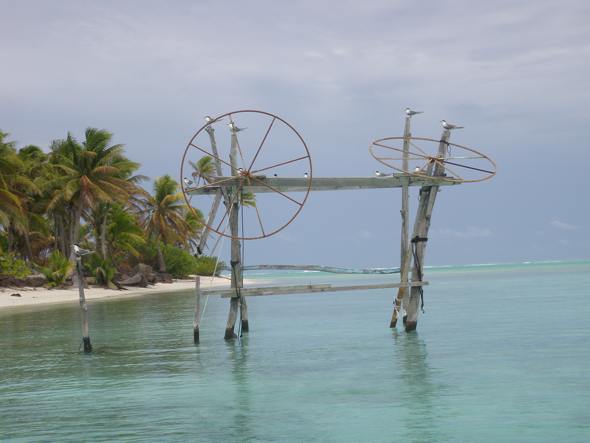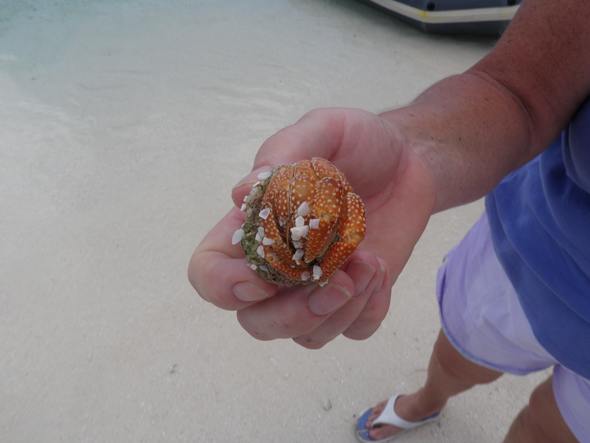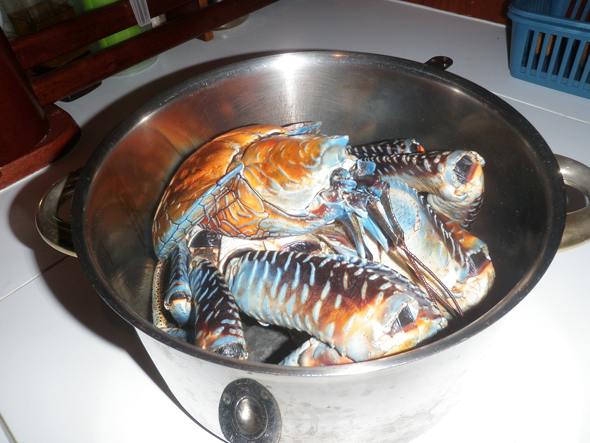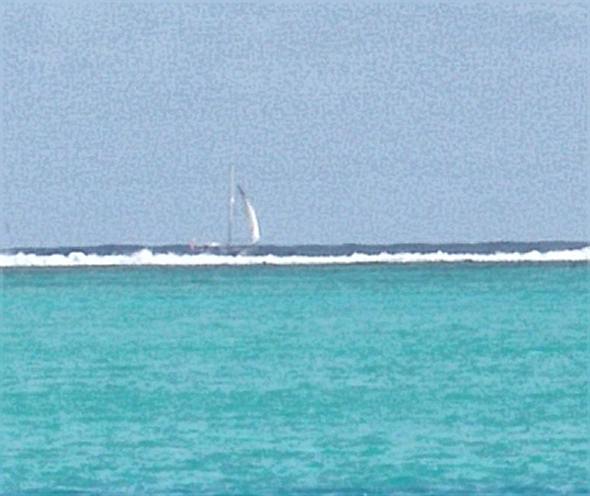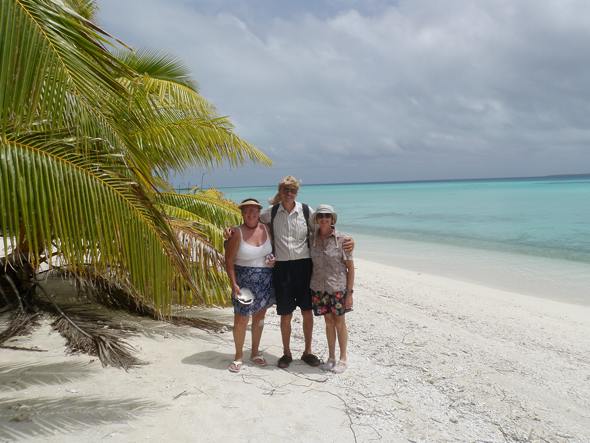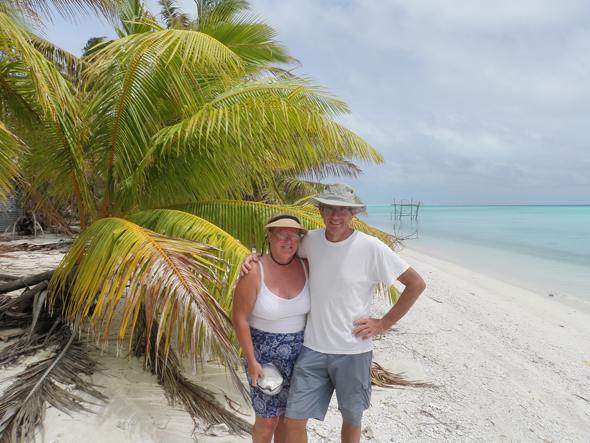Maupihaa or Mopelia - Population 10 S16 50 W153 55

|
We are now in the most westerly and most isolated of the inhabited Society Islands and therefore in the most westerly part of French Polynesia. Maupihaa is a hundred miles from its nearest neighbouring inhabited island Maupiti. It is an atoll, no volcanic island in the middle, simply a vast circular lagoon 8 kilometres wide surrounded by coral motus (small islands) covered in coconut trees and other bits of jungly vegetation, it is more like the Tuamotus than the Societies.
Motu Maupihaa, the biggest and only inhabited Motu around the lagoon. Getting in here was quite an excitement as there is only one pass and this is the narrowest reef pass that we have encountered with the fastest out-flowing current of up to 9 knots. The sea constantly crashes over the reef into the lagoon and has to find a way out.
It rushes out as it is squeezed through the reef pass causing boiling turbulence in the middle, at low tide there can be standing waves. The technique is to go in at high water under full throttle when the current has slowed to about 4 knots and the water is relatively calm, then dodge the coral heads on the shallow inside of the pass only breathing again when the depth sounder shows deeper water. All good fun – not many yachts come here!
Getting through the reef pass at slack water with the reef very close on either side.
We anchored well in some excellent sand with some outlying deep corals. Almost immediately a yellow footed booby took residence on the dingy and proceeded to cover the bow in booby gloup. Chris tried to shoo him off but he became very vocal and beaky – rather a fearsome beak. A bit of waving with an oar drove him into the water but he stuck close and when Chris took a dive to inspect the anchor the booby pursued him and started biting his flippers, we were obviously invading his lagoon and he was asserting himself to make the point.
This is my lagoon and I quite fancy this dinghy too.
Maupihaa is inhabited but there is only one family of about 10 people. who farm the copra here. We intended to stay only for a night but have now been here for 3 days and it looks as if we will be here a while longer. The wind went up to 42 knots last night and it has continued to blow hard and rain heavily all morning. We are apparently in a squash zone coupled with a sheer zone. The squash zone is produced where a high pressure cell to the south forces the Trade winds into a narrower area and therefore increases their speed. The sheer zone occurs where the winds in the upper atmosphere are at an acute angle to the winds at ground level and create instability and therefore rain and squalls that further enhance the wind speeds. Frustratingly the boats further west are experiencing nice conditions of gentle winds and smaller swells.
Getting the weather forecast using short-wave radio.
We are able to get good forecasts here although there is, of course, no wifi. Using the satellite phone we can download weather files from Mailasail and also are able to hear sailors in other areas who do have Internet access repeating the forecasts on the short-wave radio nets. It looks as if the winds will drop in two or three days, and the most recent charts showed very light winds to our west for a day or 2. That would be OK if the seas were small but it seems likely that it will be a few days more before the swell subsides. There are few things worse than slopping about in a big sea with too little wind to keep the sails filled.
This atoll, like those of the Tuamotus, is only a few feet above sea level. In 1999 it was devastated by a cyclone and the island was left deserted for some while. There are feral pigs and chickens on the island, survivors of the cyclone when the population lost their homes and the island was abandoned. The destroyed houses and gardens hide in the trees where broken toys, smashed furniture and solar panels, rusting tools and corrugated roofs are given over to the lizards, land crabs and strangling vegetation. Previously there was a flourishing black pearl farming industry but that too was abandoned. The paraphernalia of oyster farming and beautiful empty shells are still strewn about the treeline where they were thrown up in a tangle with coral, buoys and fishing nets. Buoys still adorn the lagoon, some have become coralised like dangerous stalks in the water.
Only the water cisterns of the destroyed houses are still in tact, this is where people sheltered during the cyclone. They also lost their boats, above is the remains of a hoist for hauling dinghys up out of the water, now a roost for sea birds.
We have been ashore twice and met the family who live here now. They were friendly but much poorer than most of the islanders we have met elsewhere. However, even here they have satellite TV and they even have a quad for roaming the island. It is 100 miles to the nearest shop so the locals have to be very self sufficient. The family keep pigs, harvest coconuts and catch coconut crab, lobster and fish. This is supplemented by occasional trips to other islands when medical treatment or purchase of large goods is needed, by the small ships that collect the copra and bring in supplies including fuel for cooking and outboard motors. At this time of year they do benefit a little from cruisers stopping and giving them supplies. We took cornmeal, sugar and papayas as well as some sweeties, pencils, paper and games for the children. Other yachts had taken in rice, corned beef and the like. Sadly the woman we met, who has 3 young children, has some serious illness. She was telling us that she has had treatment in Tahiti and will have to return there for more treatment soon. Just getting to Tahiti is a major undertaking. The worst part being the boat ride in an open boat 200 miles to windward, a trip that given the current conditions would sometimes be impossible. There is no ferry service and no airstrip so these people are very isolated in an emergency. The 3 little boys of 1, 2 and 9 years old will not start school until they are 10 when they must leave their family and go to school in Tahiti, a trauma for children brought up in a tiny close community.
Since starting this blog we have had a visit from the father and two of his small sons of 9 and 2 years. I thought the father was asking for honey (miel) and routed out our only jar but he was actually saying mail. He wanted to send an email to a French cruiser who has been here a number of times and as I understand it is representing him in a battle over whether he has the right to stay on the island. I duly typed out the letter he brought and sent it of while Lorraine played with the children. The upshot of all this is we now have a large and rather beautiful coconut crab for supper!
Kalami caught this crab by reaching his hand into its burrow and dragging it out - no mean feat, this crab is powerful and heavy. This is definitely an acquired skill, its two awesome claws are absolutely something to be avoided. These crabs are becoming rare in Polynesian islands with larger populations and hotels but here the island is literally crawling with them. It is a fearsome looking beast of blue and orange with enormous claws which are apparently able to carve their way into a coconut although they do eat other things too. In fact we realised we have seen the young crabs in quite large numbers on the shoreline. They use shells in the same way as hermit crabs when they are young, although they struggle to put all their oversize legs and claws away.
We only just had a pot big enough for the crab which weighed about 5 pounds but cooked in 20 minutes, the shell was very thick and took some cracking.
The legs and claws are eaten and locals eat the contents of the fat squidgy tail as a sort of paté. It was very like lobster and made delicious eating but we did forego the tail which fed the remora which cling to the bottom of our boat waiting for scraps as they do when they cling to sharks.
We have been able to do a bit of exploration between the blasts and the downpours and there is one other boat, Sal Darago, sitting it out like us but not a lot to do as the snorkelling is best on the reefs which are inaccessible because of the weather. Sal Darago sailing ocean side of the reef before passing into the lagoon and Lorraine with Cathy and Jeremy from Sal Darago . . We have done lots of outstanding jobs on board, Chris has polished and de-rusted various hull parts whilst I have made a new fitted sheet for the forecabin berth. We have been beach combing and paddling in the margins taking care not to tread on stone fish or squash baby coconut crabs. Frustrating as the lagoon is reasonably unruffled by this stormy weather but it is still rough outside. We continue to wait for our weather window to set off for the Cook Islands some four days away.
|
